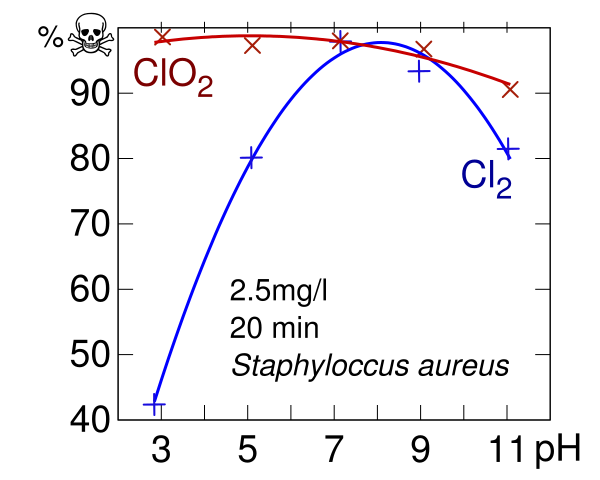S615-4.1.SANITIZER FOR HARD, NON-POROUS, FOOD-CONTACT SURFACES PT4
TWINOXIDE-GUIDELINES
TwinOxide® is an effective food contact surface sanitizer at 0.1 to 5.0 ppm depending on the degree of disinfection required, against E. coli and E. coli O157:H7, Salmonella typhimurium (MDRS), and Staphlococcus aureus….
The product may be used on previously cleaned food preparation surfaces; fountain drink and beverage dispensers; glassware, plates and eating utensils; food processing equipment, including beer processing equipment and lines, and food conveyor belts….


Staphylococcus aureus
http://en.wikipedia.org/wiki/Staphylococcus_aureus

Staphylococcus aureus is a bacterium that is a member of the Firmicutes, and is frequently found in the human respiratory tract and on the skin. Although S. aureus is not always pathogenic, it is a common cause of skin infections (e.g. boils), respiratory disease (e.g. sinusitis), and food poisoning. Disease-associated strains often promote infections by producing potent protein toxins, and expressing cell-surface proteins that bind and inactivate antibodies. The emergence of antibiotic-resistant forms of pathogenic S. aureus (e.g. MRSA) is a worldwide problem in clinical medicine.
Staphylococcus was first identified in 1880 in Aberdeen, United Kingdom, by the surgeon Sir Alexander Ogston in pus from a surgical abscess in a knee joint.[1] This name was later appended to Staphylococcus aureus by Rosenbach who was credited by the official system of nomenclature at the time. It is estimated that 20% of the human population are long-term carriers of S. aureus[2] which can be found as part of the normal skin flora and in anterior nares of the nasal passages.[2][3] S. aureus is the most common species of staphylococcus to cause Staph infections and is a successful pathogen due to a combination of nasal carriage and bacterial immuno-evasive strategies.[2][3] S. aureus can cause a range of illnesses, from minor skin infections, such as pimples, impetigo, boils (furuncles), cellulitis folliculitis, carbuncles, scalded skin syndrome, and abscesses, to life-threatening diseases such as pneumonia, meningitis, osteomyelitis, endocarditis, toxic shock syndrome (TSS), bacteremia, and sepsis. Its incidence ranges from skin, soft tissue, respiratory, bone, joint, endovascular to wound infections. It is still one of the five most common causes ofnosocomial infections and is often the cause of postsurgical wound infections. Each year, some 500,000 patients in American hospitals contract a staphylococcal infection.[4]

Wirksamkeit von Chlordioxid und Chlor (Konzentration iodometrischbestimmt) gegen das Bakterium Staphylococcus aureus: Prozent getöteter Bakterien bei verschiedenenpH-Werten nach 20 Minuten Desinfektion mit Chlordioxid oder Chlor.[42]
Huang Junli, Wang Li, Ren Nanqi, Ma Fang and Juli: Disinfection effect of chlorine dioxide on bacteria in water. In: Water Research, 1997, 31 (3), S. 607–613;doi:10.1016/S0043-1354(96)00275-8
Abstract
In this paper, the disinfection effects of chlorine dioxide (ClO2) on some main bacteria in water and the influence of ClO2 on the inactivation of some microorganisms studied under various conditions such as the dose of disinfectant and the contact time, pH value, etc. were researched and reported, and it was compared with that of liquid chlorine. The results showed that the killing effect of the ClO2 on bacteria is similar to or better than that of liquid chlorine, the bacteria were effectively killed off by using ClO2 in a relatively wider range of pH value. Moreover, the investigation of the bactericidal mechanism of ClO2 was tentatively undertaken. Then, we concluded that ClO2 is an excellent disinfectant to substitute for the liquid chlorine.
***************************************************************
Image from the Twin oxides library:
This picture shows the inactivating effect of the Twin Oxide-Chlorine dioxide water on the test organisms Staphylococcus For comparison, you can see above the nutrient solution; bottom right raw water is shown before treatment; bottom left you will see the hygienically clean chlorine dioxide water
***************************************************************
Own observations
2008-Benin
Image from the Twin oxides library:
This picture shows the inactivating effect of the Twin Oxide-Chlorine dioxide water on the test organisms Staphylococcus For comparison, you can see above the nutrient solution; bottom right raw water is shown before treatment; bottom left you will see the hygienically clean chlorine dioxide water

No comments:
Post a Comment